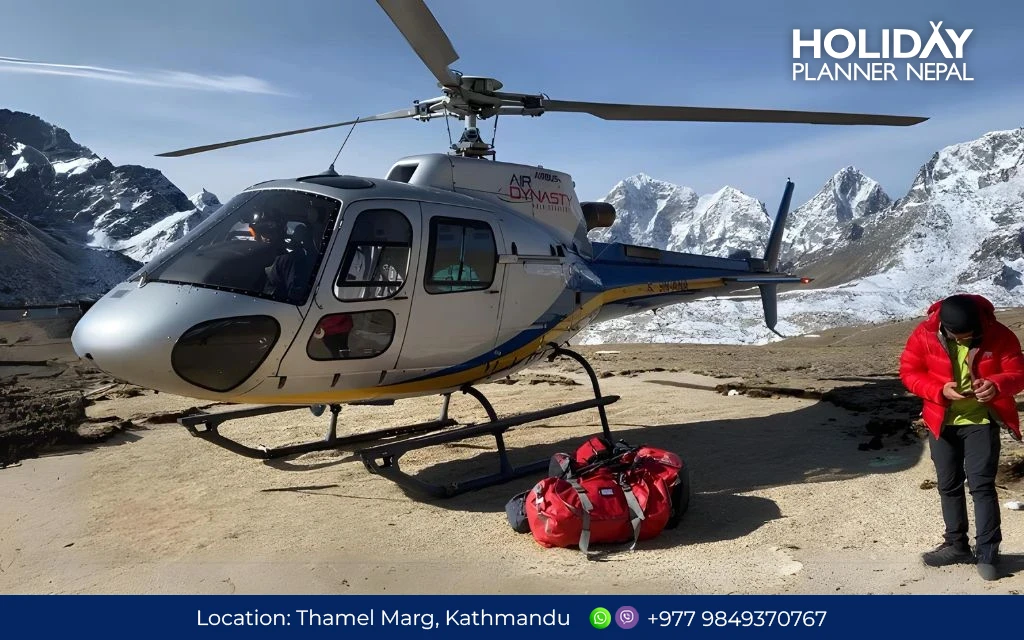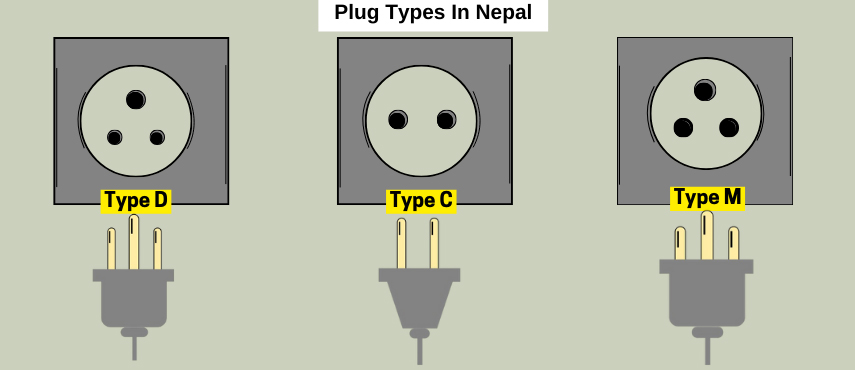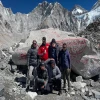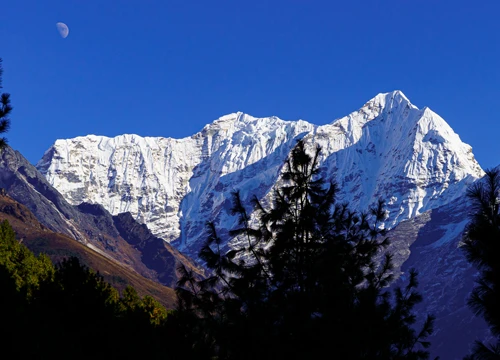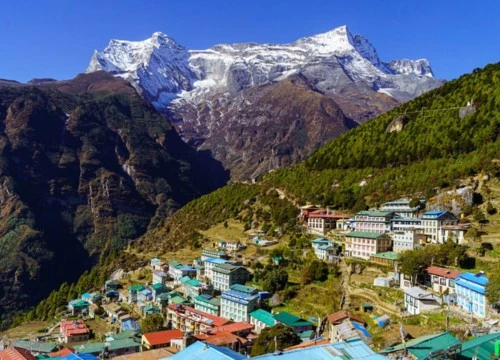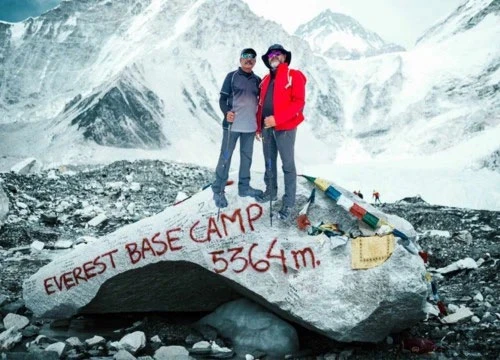Why Choose a Helicopter Tour to Everest Base Camp?
Traditional Everest Base Camp treks take 12–14 days, involving steep trails, altitude changes, and extensive physical stamina. However, a helicopter tour compresses this incredible experience into a single-day adventure, making it accessible for everyone.
Key Advantages:
Time Efficiency: Reach Everest Base Camp in a few hours instead of trekking for days.
Safety and Comfort: Modern helicopters are equipped for high-altitude flights, ensuring safety and convenience.
Spectacular Aerial Views: Witness Everest, Lhotse, Nuptse, and Ama Dablam from the sky—perspectives impossible from the ground.
Flexibility: Tours are available for individuals, families, groups, and even luxury travelers.
Whether you are short on time, have physical limitations, or simply want to experience the Himalayas in style, a helicopter tour offers an unrivaled opportunity to witness the world’s tallest mountains up close.
Highlights of the Helicopter Tour to Everest Base Camp
Mount Everest: The world’s highest peak, 8,848 meters above sea level.
Kala Patthar: Offers panoramic views of Everest and surrounding peaks.
Khumbu Glacier: A massive glacier that showcases the raw beauty of the high Himalayas.
Ama Dablam: Known as the “Matterhorn of the Himalayas,” Ama Dablam is a favorite among photographers.
Namche Bazaar from the Sky: View the bustling Sherpa town that is the gateway to Everest treks.
Every moment of this Everest helicopter ride is an opportunity to capture stunning photos, enjoy the serene beauty of the mountains, and marvel at nature’s grandeur.
How does the Everest Heli Tour begin and end?
The Everest Short Trek with Helicopter Return begins with a flight to Lukla from the bustling city of Kathmandu. The flight to Lukla, also known as the "Gateway of Khumbu region," takes about 25 minutes from the capital city and lands at Tenzing Hilary Airport of Lukla.
Upon landing, the Trek begins towards Phakding and then to Namche Bazaar. Namche, situated at 3,440 meters/11,290 feet, will be the most suitable place for acclimatization in the decreased oxygen level. For this reason, trekkers on the Everest Short trek will take a rest day at Namche, where they can explore prominent places in and around Namche.
After a good day's rest at Namche, the helicopter tour of Everest commences the following day. Individuals will fly over the clouds of Namche and towards Everest Base Camp. However, the helicopter landing will occur at Kalapatthar, as Kalapatthar has the best view of Mount Everest. The Everest Helicopter tour also provides breathtaking panoramic views of mountain peaks from Kalapatthar.
The helicopter tour lasts about half an hour, thus providing enough time to immerse oneself in the Himalayan region of Nepal. However, there is no provision for landing the helicopter at Everest Base Camp because of numerous protocols, such as thin air, limited space, and weather conditions.
Similarly, after spending some time in Kalapatthar and enjoying the view, visitors will return to Lukla, from where passengers will take a flight to Kathmandu, hereby ending the journey of the Everest helicopter tour with a short trek.
Flight Experience: A Journey Through the Himalayas
A typical Helicopter to Everest Base Camp departs from Kathmandu or Lukla, depending on your travel plan. The moment you take off, the adventure begins:
Kathmandu Valley Takeoff: As the helicopter lifts off, enjoy stunning aerial views of the valley, historic temples, and surrounding hills.
Crossing the Sun-Kissed Hills: The flight passes through rugged landscapes, rivers, and terraced fields. Your guide or pilot provides fascinating commentary on the terrain below.
Approaching the High Himalayas: The aircraft ascends, offering close views of snow-capped peaks, glaciers, and high-altitude villages.
Everest Base Camp and Kala Patthar: Many tours include a landing or hover near Everest Base Camp and a stop at Kala Patthar, providing the best photo opportunities of Mount Everest.
Passengers often report an emotional experience, seeing the vast Himalayan ranges from a perspective few have the privilege to witness.
The Helicopter Tour to Everest Base Camp - 6 days altitude and distance chart
Day | Activity | Altitude (m/ft) | Distance (km/miles) | Duration (hours) | Elevation Gain/Loss |
01 | Arrival in Kathmandu and transfer to the hotel | Arrival: 1,350m/4,430ft | — | — | — |
02 | Fly to Lukla and trek to Phakding |
2,860m/9,383ft | ~7.4 km / 4.6 miles | ~3-4 hrs walk | +1,440m / +4,724ft (flight) |
03 | Trek from Phakding to Namche Bazaar | 3,440m/11,286ft | ~11.5 km / 7.1 miles | ~5-6 hrs walk | +830m / +2,723ft |
04 | Rest and exploration day at Namche | 3,440m/11,286ft | ~4 km / 2.5 miles (hike) | ~2-3 hrs hike | +440m / +1,443ft (hike) |
05 | Helicopter tour of Everest Base Camp and surrounding peaks, then return to Lukla | 5,364m/17,598ft | ~20-25 km / ~12-15 miles (flight) | ~2 hrs (total) | +1,924m / +6,312ft (flight) |
06 | Fly back to Kathmandu | 1,350m/4,430ft | ~138 km / ~86 miles (flight) | ~30 min (flight) | -1,440m / -4,724ft (flight) |
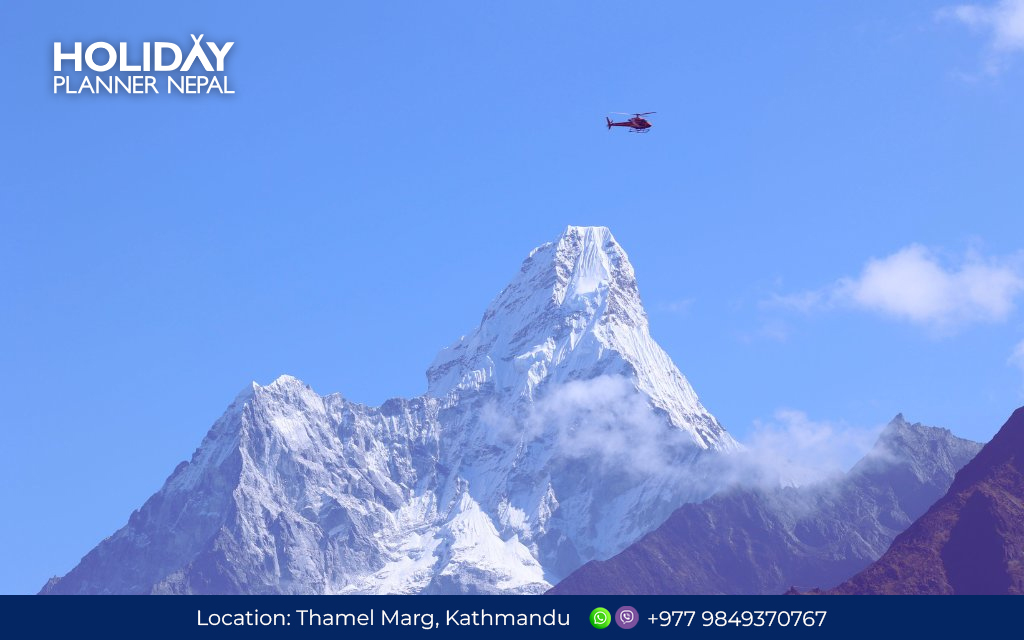
For whom is the The Helicopter Tour to Everest Base Camp suitable?
The Short Everest Trek with Helicopter Tour is suitable for a varied range of age groups who have a basic level of physical fitness. As the trekking package includes walking from Lukla to Namche, it does require some physical fitness and can be completed only by those individuals or age groups who are capable of walking at least four hours per day. The following points summarize the suitability of the Trek in the Everest region with a Helicopter tour.
- Individuals who wish to see Mount Everest with the minimum effort of walking in the trans-Himalayan and remote areas of Nepal.
- Adventurers who wish to take a unique approach to exploring the Everest region of Nepal.
- Wildlife enthusiasts who are on a search for exotic flora and fauna of the Solukhumbu region and Sagarmatha National Park.
- People who are interested in acquiring information about the culture and lifestyle of the Sherpa people, their mountaineering history, and trekking culture.
- Photographers, vloggers, cinematographers, and content creators who want to capture the spectacular scenery, iconic landmarks, cultural richness, exotic animals and birds, and natural beauty can take this trekking package.
- The trek is for first-time trekkers who are new to trekking and have minimal experience trekking at higher altitudes.
Local culture and tradition in the Everest region
The Sherpa community inhabits the Everest region, renowned for its trekking and mountaineering expertise. Prominent villages like Lukla, Phakding, and Namche have sherpa people who live in these extreme climatic conditions and live their lives. The sherpa people's primary occupation is assisting climbers to the summit of the mountains.
Old Sherpa culture and tradition prevail in the Everest region. Along the routes to Everest Base Camp, mani walls encrypted with chants and mantras, surrounded by prayer flags and prayer wheels, can be seen. There are many Tibetan chortens, stupas, and temples in the area, which portray the Buddhist and Hindu culture of the community.
Similarly, the Sherpa people are primarily influenced by Tibetan Buddhist culture, as evidenced by shrines, sculptures, gompas, and prayer wheels in the region. The presence of Tengboche and Pangboche monasteries in the Everest region is proof of the prevailing rich culture and tradition.
The main festival for the people of Everest is the Mani Rimdu festival, also known as a trekking festival. The festival, which lasts 19 days and is celebrated in Tengboche monastery, marks the founding of Buddhism by Guru Rinpoche Padmasambhava. It includes masked dance, cultural performances, and tasting of local delicious cuisine.
On the other hand, the culture of the Sherpa people resembles the level of hospitality they provide to their guests. Tea houses, lodges, or any accommodation option warmly welcome trekkers with immense hospitality and respect. This provides an opportunity for community gatherings, ceremonies, and communal work, fostering a strong sense of togetherness among the community.
Thus, the local culture and tradition are rich and diverse, allowing tourists from all over the world to come here to witness the lively environment and savor the rich culture and tradition first-hand.

